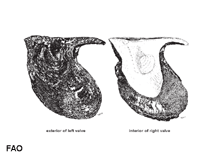Pteria penguin (Röding, 1798)
Penguin wing oyster| Native range | All suitable habitat | Point map | Year 2050 |

|
| This map was computer-generated and has not yet been reviewed. |
| Pteria penguin AquaMaps Data sources: GBIF OBIS |
Классификация / Names народные названия | синонимы | CoL | ITIS | WoRMS
Bivalvia | Ostreida | Pteriidae
Environment: milieu / climate zone / пределы глубины / distribution range экология
; пределы глубины 0 - 35 m (ссылка 348), usually 0 - 35 m (ссылка 75831). Tropical
Distribution страны | регионы FAO | Ecosystems | места находок | интродукции
Indo-West Pacific: from East Africa and the Red Sea to Fiji Islands; north to southern Japan and south to northern Queensland and Western Australia.
Length at first maturity / Size / Weight / Возраст
половая зрелость: Lm ? range ? - ? cm Max length : 30.0 cm SHL самец/пол неопределен; (ссылка 348); common length : 20.0 cm SHL самец/пол неопределен; (ссылка 348)
Краткое описание морфология
Life cycle and mating behavior половая зрелость | размножение | нерест | Eggs | Fecundity | Larvae
Основная ссылка
ссылки | координатор | соавторы
SAUP Database 2006 SAUP Database. www.seaaroundus.org. (ссылка 356)
Статус Красного Списка МСОП
(ссылка 130435: Version 2025-1)
Статус СИТЕС (ссылка 108899)
CMS (ссылка 116361)
Угроза для людей
Использование человеком
рыболовство: коммерческий
FAO - аквакультура (рыбоводство): production; | FishSource | Sea Around Us
инструменты
дополнительная информация
ресурсы в Интернет
BHL | BOLD Systems | CISTI | DiscoverLife | FAO(; publication : search) | Fishipedia | GenBank (Геном, Нуклеотид) | GloBI | Gomexsi | Google Books | Google Scholar | Google | PubMed | Tree of Life | Wikipedia (Вперёд, поиск) | Zoological Record



